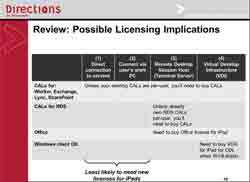News
Analysis: Breaking Down Microsoft's BYOD Licensing
- By Kurt Mackie
- June 29, 2012
Windows shops may find licensing for bring-your-own-device (BYOD) scenarios somewhat perplexing due to the architecture used to access Microsoft's servers, according to Rob Horwitz, research chair at Directions on Microsoft, an independent consultancy that's been tracking Microsoft for 20 years.
Horwitz spoke on the licensing implications of BYOD in a webinar on Thursday. Under BYOD, employees are empowered to bring their own laptops, smartphones or tablets to work to access the company network, or they can access the network remotely with their devices. However, that access can come with extra costs, depending on the licensing used. Factors include the network access method and architecture, the location of the device, the type of device used, and the Microsoft licensing secured by an organization.
According to Horwitz, the "your" in the BYOD terminology under Microsoft's licensing means either the employee bought the device or got a stipend from the company to purchase it. While Horwitz used the Apple iPad as an example during the webinar, Microsoft's licensing principles equally apply to Android, Windows and other devices in BYOD scenarios.
Surprisingly, the location of the user actually matters under Microsoft's licensing in BYOD cases.
"Why would on premises/off premises matter? It only matters because Microsoft says it does," Horwitz said.
In defining a companion device, Microsoft's contractual language uses the phrase "not managed controlled." In response to a question, Horwitz noted that this phrase isn't defined by Microsoft.
"With respect to these devices, managed or controlled, if you own an iPad, it's not considered managed or controlled," he explained. "If a device has virus protection, that could be interpreted as a level of control."
Architecture and Licensing
In order for a device to access a Microsoft server, Client Access Licenses (CALs) are required by Microsoft for the device. That's true regardless of whether the server is Exchange, Lync, SharePoint or Windows Server. An organization can choose whether to license the CALs on a per-device basis or a per-user basis. Additional licensing for Microsoft Office and the Windows client OS also have to be considered, Horwitz explained.
Four architectural scenarios can affect BYOD licensing costs in Windows shops. In one scenario, users directly access Microsoft servers, and that access requires CALs. A second scenario involves users remotely connecting to their work PCs. A third scenario has the user connecting to the server via Remote Desktop Services (RDS, formerly known as "Terminal Services"). A fourth scenario is the use of Microsoft's virtual desktop infrastructure (VDI) technology, where each user connects to a virtual machine hosted on Windows Server.
Users remotely connecting to a server can be noncompliant with Microsoft's licensing if the existing CALs are licensed on a per-device basis. Horwitz explained why that's the case, stating that CALs "must always live with the endpoint device" to be correctly licensed. The point is underscored in Directions on Microsoft's "possible licensing implications" summary chart (see below).

[Click on image for larger view.] |
| Possible licensing requirements relative to Windows network infrastructure in BYOD scenarios. Source: Directions on Microsoft webinar, June 28, 2012. |
CALs also must be in place for devices using Microsoft's RDS and VDI technologies. It costs $85 per user per device for an RDS CAL, which is required even when using Citrix products, Horwitz said. With regard to using Office via RDS or VDI, an iPad device would be required to have a Microsoft Office license. Moreover, the version of Office on the iPad needs to match what's on the server to be correctly licensed, he explained.
On the Horizon
Microsoft briefly announced in April that forthcoming Windows RT ARM devices will have Virtual Desktop Access (VDA) access rights by default if they are used as a companion device to Software Assurance-covered PCs. Microsoft's VDA option is a per-device license permitting VDI access. VDA licenses are priced at $100 per user per device, but organizations with Software Assurance coverage on their PCs get VDA rights included at no additional cost.
Other devices, such as an iPad, may require the purchase of a new Companion Device License (CDL) to gain that same VDI access, Horwitz explained. Each CDL covers up to four devices. He noted that the definitive details aren't yet publicly available from Microsoft.
More insights on Microsoft's licensing can be found in Directions on Microsoft's licensing publications. Its analysts also share their expertise in a regular series of Microsoft Licensing Boot Camp seminars.
About the Author
Kurt Mackie is senior news producer for 1105 Media's Converge360 group.